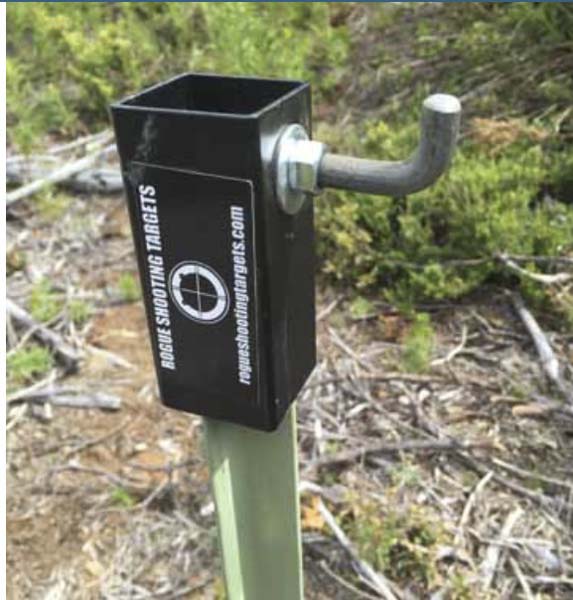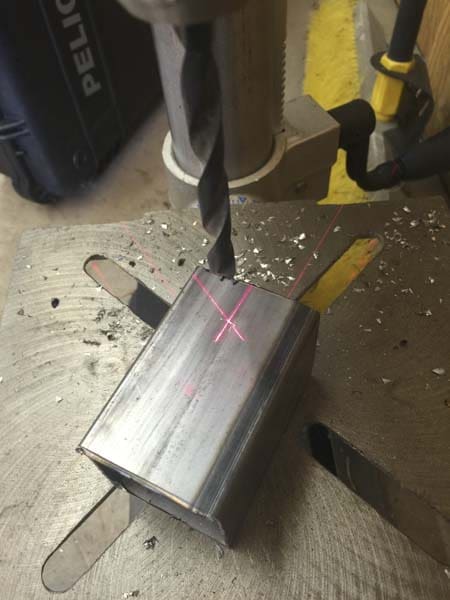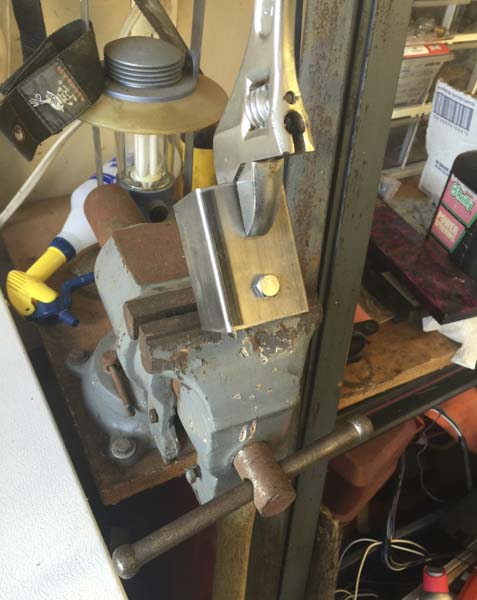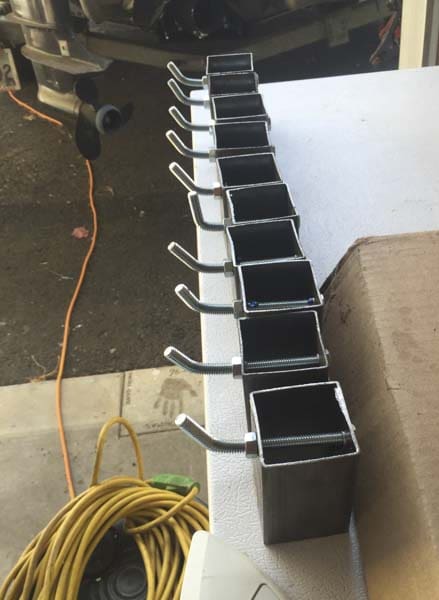
Recently, Joe Grine posted a story featuring the above Rogue Shooting Targets t-post target hangars. While they’re a great idea, I thought the price seemed a bit high. I tend to be a “do it myself” kind of guy, so with a shooting date coming up with Joe and a few other guys, I thought I’d add my steel plates to the range fun.
First off, I measured the end of a common T-post to see what the dimensions were so I could buy the proper sized square tubing. A quick stop at my local steel supplier was then in order. After finding the correct size, (I chose 2″ x 2″ square milled steel, .080 wall thickness). Then I gave a thought to how long it would take me with a hand operated hack saw to cut 10 pieces up.
Not liking that, I asked if the steel supply place would cut it up for me. Yup…at $1.75 per cut. So I gave them the green light. The next morning, I picked up ten three-inch pieces of cut up steel.

Off to the local hardware store for some bolts and nuts. Four-inch long threaded 3/8″ diameter mild steel should do the trick.
Then to the drill press in my shop. X marks the spot for the holes.

Put the bolts through the holes, tighten them, and this part is done.

Next step: bend the bolts. No need for a torch, just a vice and a crescent wrench.

So I did make one small mistake here. I bent one bolt a bit too far and I could feel it partially break. Next time I’m in town, I’ll just buy another bolt and bend it a little less.
I’m pleased with the end result…10 steel plate target hangars.

You can see the broken bolt, fifth one up.
While Joe paid $37.50 per pair for his hangars, I’m into mine for considerably less. Total cost for ten hangers:

Grand total: $31.73. Your mileage may vary depending on the cost of steel in your area.
It took me about an hour to make them. I suppose I could paint them and de-bur the edges to make them prettier. Also, this project would have only been $14.23 had I chosen to work up a sweat cutting these things by hand. So for those of you with a little more DIY attitude, that gets it down to $1.43 per hanger.
Now I’m all set for the range trip to Mt. Hood. This will be great preseason practice for long range shooting. I’m headed for the Hells Canyon wilderness area for first season elk. Stay tuned.




Needs more Crisco.
You and I both know that would be a waste of time.
Very well done.
(and thanks for the chuckle)
“Then I gave a thought to how long it would take me with a hand operated hack saw to cut 10 pieces up.”
Buy a Port-A-Band. If you don’t have one in your garage you have no business working with steel. $1.75 a cut is highway robbery. Or go whole hog and drop $250 for a 1HP legit metal cutting bandsaw from Harbor Freight and buy some decent blades for it. That eliminates the learning curve of learning to cut straight with a Port-A-Band.
I’ve had both from HF and I’ve beat the snot out of them for nearly five years with no problems. When they do eventually break I give no fucks. Total investment of like $380 has kept my little shop running for half a decade.
Don’t get me wrong, I have the portable (and non) bandsaws. But for this, I’d have used the $99 cut-off saw. 1 minute per on the bench grinder to remove the flash, and done.
My preference is for band saws because they make a smoother cut, that’s due to the fact that I eventually got sick of cleaning up shitty things done by welder’s helpers. The less rotary tool action I need after the cut the better IMHO. Cut, weld, hit it with a wire brush wheel (if welding was stick), done.
Nothing against the chop saw for quick and dirty jobs, but I’m a perfectionist about fabrication.
Perfectionist… Harbor Freight.
Something doesn’t add up here. 😛
Aaaanyway, if you were a perfectionist, you’d have a cold saw.
I agree with your point, I think we just differ on whether to count this as “fabrication”. I look at this as the definition of quick and dirty. I’ll do whatever must be done to make it work properly, beyond that – I’m gonna be shooting at it.
“Aaaanyway, if you were a perfectionist, you’d have a cold saw.”
Pffftpt.
# 1, Wire EDM. #2, Plasma or laser, or water-jet for the coolest (temp) cutting…
Swarf:
The usefulness of a bandsaw comes from the blade, not the electrical engine that drives it. You can overtax any bandsaw and burn it out.
What’s the point in a $400 Milwalkee that’s exactly the same when it comes to the blade? There is none. You either know now to operate the tool and not destroy it or you don’t. So buy the cheapo saw and put a nice blade on it and it will cut just as well as a “nice” saw.
As for a cold saw, they’re overpriced for what they are and what I intend to do. I can get sub 1/8″ out of a Port-A-Band and weld over the difference to the point you’d never know there was one. Besides, if I’m looking to make it look nice (which I am) I’m gonna give the edges a bevel anyway so as long as the cut doesn’t bow I don’t care. I’m concerned about a making a good looking, full pen weld that’s X-Ray quality.
When I say I’m a perfectionist I mean the outcome and smooth, straight and NARROW cuts make that easier to achieve.
16V: It’s basic fabrication of something you intend to destroy. You may do as you wish with it. I still take pride in my work and strive not to fall into bad habits. For example: nearly all the welding and other metal work I see in the real world screams to me “Someone doesn’t know what they’re doing or doesn’t actually care”. I see welds on structural stuff that, were I the CWI, they’d hate me when I told them “Grind that the fuck out and redo it. Don’t you know what crater crack is and how high the probability is that it will cause a longitudinal crack inside this weld?”.
Check out the shitty work on stairs in a place like a hospital and tell me it makes you feel better about how the building was built.
At Geoff:
By the time you get to serious computer driven machine cutting you’re doing the touchup work, or 6G by hand and letting other machines do the rest.
strych9, We are not welding anything. We’re talking about whacking out a few cuts, drilling some holes, sticking a bent chunk of bolt in it, then freakin’ shooting at it. Giving a good-flyin’ is the only reason the Chi-Coms will make it for even less money.
Just bite the bullet Tom and buy the dadgum bandsaw, chop saw, coldcut saw, mig welder, tig welder, portaban, bench grinder, hand grinder, dremel, air compressor, drill press, mill and lathe. Don’t be showing us your ‘DIY’ projects that were done with minimal tools and old fashion ingenuity. They’re not DIY until you’ve got a shop full of real big boy toys
I’m inclined to believe Tom has other things he’d rather spend his money on, like African safaris or guns-n-ammo.
Beer money can buy goodwill from friends with shops, you know… 🙂
Would heating them with a torch before bending them help or hinder the bolt cracking problem?
I’m not sure. I do know they work great. We are up on the side of Mt. Hood as I write this. Getting some great trigger time in, from 300 to 900 yards.
Tom, would you mind sharing where you can shoot out to 900 on Hood? No worries if it’s your secret spot, but I’d love to have access to that much range that close to PDX.
Sorry Nick. I didn’t develop it, so it’s not mine to share.
It depends on what they’re made of and what they’re coated with.
These look like they’re zinc plated. With zinc coatings or galvanization heating them up to the point they made the steel underneath softer and significantly easier to work with would have you running to the bathroom and not making it before you shit your pants if you did it without an air-pack or a really high end respirator. Then you’d be drinking milk and feeling like crap for the next few days.
You wanna clean that stuff off before you try heating it up. A wire brush on an angle grinder will do it nicely, just don’t miss spots. Vaporized zinc is pretty gross and heavy metal fever isn’t fun.
If it’s a steel bolt then a MAP gas torch would help you bend them without breaking them, just make sure to let them cool in the air rather than quenching them in water when you’re done. A can of spray or paint on galv will cover up where you removed the coating. Of course acetylene would work even better but the bottles for that stuff are expensive and if you don’t know how to set a cutting torch you shouldn’t play with one.
Heavy metal fever isn’t fun, you say? I’ve had the fever nonstop since 1983, and it’s more fun now than it ever was. (Oh, wait…vaporized zinc? I thought you were talking about Van Halen.)
” Vaporized zinc is pretty gross and heavy metal fever isn’t fun.”
Do it outdoors like the clandestine chemists and keep the work downwind…
It doesn’t make a difference. You don’t need to inhale much to get sick for a few days and shit yourself.
When a building is built the frame is put up, then a corrugated piece of steel is put down so that concrete can be poured between the I-beams for the floor. That stuff is galvanized. The guy’s who weld it don’t give a shit because they have supplied air in most cases. They come along and weld right through the galvanization for an inch or two every so often (depending on specs). This is done while the floor is totally open to the wind.
A common trick to pull on a new welder/helper in this case is to have them walk behind you carrying your leads without a mask. Just a decent whiff of the stuff that comes off one of those 1″ welds is enough to send them running to the port-a-john and everyone laughs about it.
It doesn’t take much zinc like this at all to make you sick as hell for a few days. Zinc Oxide is the culprit.
To avoid this, NIOSH recommends a P100 or N95 filter at concentrations of 50 mg/m^3 anything higher requires supplied air in continuous flow plus a backup mask for escape.
Symptoms of heavy metal fever will present at a concentration of 5 mg/m^3. To put that in context, that’s 0.05 grams per cubic meter of air. It don’t take much. You can easily give yourself this problem by getting a whiff off a bolt you’re dicking with and being outside isn’t going to help you. If you’re going to try doing that, remove the galvanization (recommended) and regalv after being done or, since you pretty much have to stand there to heat this up, wear at least a half face respirator with at least a P100 filter on it. Realy, I’d recommend the 3M black stripes which are activated charcoal + P100 + an extra filter.
General rule of the welder who hasn’t gone full retard: never weld over galvanization.
I agree with strych9, do not cut or weld galvanized/zinc coated materials. The fumes are dangerous. If you are going to torch it and weld, just buy cheap steel rod. It will be cheaper than the galvanized stuff. Tom in Oregon was right not to heat it with a torch.
“It doesn’t take much zinc like this at all to make you sick as hell for a few days. Zinc Oxide is the culprit.”
I was not aware of that, thanks for the heads-up on it!
When I’ve worked with some real chemical nastiness, I did it under a fume hood running full blast…
I would think you should consider getting all thread rod. It is usually available in plain finish and low grade strength at lower cost than fully threaded bolts. You will need nuts and will have to cut it, but no worries about heating and bending.
Those look like J bolts . Why buy some bolts and bend them when they come that way already
J-Bolts are threaded at the end of the J. Wouldn’t work, and now that you’ve thought about it for 2 seconds, uttering a “duh-oh”, you remember why.
That, and J-Bolts cost money as opposed to some ungraded bolts from the bin for a few dimes per.
J-bolts could work just fine. You’d just need an extra nut and washer for each. Thread one nut on inside the tube and thread the other nut on outside. TIghten ’em up to lock the bolt in place with the short half of the J sticking out far enough to slip the steel plate on, and you’re in business. As to cost, J-bolts are less than a buck apiece. You’d still be way, WAY under budget compared to the commercial version, even with those pricey J-bolts.
Do give examples of the “cheap” j-bolts that are allthread. Please, I’ve never seen them in 40 years, do explain who makes them, and where one can find them.
They don’t need to be all-thread, as I explained. There’s no need to sandwich the entire piece of tubing with the fasteners, you can just use two nuts to secure it on the back wall, one inside the tubing and one outside. You only need an inch or less of threading on the long leg of the J.
Like so (pardon the bad ASCII drawing, the curved part of the J would be to the left, but you can’t really draw that with keyboard characters):
| |
====|====[]|[]==
| |
There’s probably no need to get all worked up and hostile. We’re just talking about ways to make cheap target hangers here. Nobody’s challenging your decades of experience in the J-bolt industry.
I think you need the uh duh moment as you’re so smart that you’re just as stupid . Home Depot sells these j bolts all threaded less than a $1.00 a piece . But go ahead spend all that time and effort making your own cause you’re such a tight wad you sqeak when you walk
I have no dog in this fight, but on reading it I might as well chime in…I rarely find any kind of bolts threaded all the way anymore, especially in Home Depot. Damn near everything is shouldered. Anyway, even if it is fully threaded I often need odd shapes.
However, for a scant few bucks I buy standard grade threaded rod which is plenty strong enough for projects like this and easy to bend and cut to length. I get plenty of whatever funny shaped bolts I need out of each piece of rod. Tractor Supply has bulk hardware so I usually buy there, where I can also buy a big bag of nuts/washers in my choice of grade, fistfuls paid by the pound.
Tip: Bend it first when it’s long. Stick it into a hole in something sturdy, like an unused bolt hole in a boat trailer. Then slip a piece of pipe over it and bend. Then put some nuts on both sides of where you intend to cut before cutting; cut with your favorite tool (I prefer a cutoff wheel in an angle grinder), and unscrew the nut to straighten any bent threads. (Extra credit: Put the nuts on before bending, if the pipe fits over them.)
Where on Mt. Hood do you shoot those ranges? I am only a hop, skip, and jump away from there.
I know there was already a nice comment thread recommending spending tons of cash to fill tons of bench space with all manner of high-end shop tools that I wish I could have (hell, I wish I had a drill press), but for $30 at HF you can have a decent enough angle grinder (their “heavy duty” model is inexpensive, works great, and will last forever for your application) and some cutoff wheels to make quick work of all manner of thick steel cutting (and grinding). A few more of those paid cuts and it would have paid for itself. It takes some care to get a perfectly square, clean cut, but way less care than doing it with a hacksaw!
Agree. Tom mentioned “hacksaw” and I was like – Oh F no.
HF $8 cut off saw (pneumatic)
http://m.harborfreight.com/3-in-high-speed-air-cut-off-tool-69473.html
I have that HF 3″ air cutoff saw. It’s probably great for thin and medium sheet metal (like auto body work) but doesn’t handle thicker metal well with the 5CFM that it specifies…maybe a compressor with more flow could make it more useful for that stuff.
Looking at the photos of the cut tubing, it would be unsatisfactory. I’ve cut steel that I think was of similar thickness and it was too lame to bother. My example may have been a little thicker though.
Cyril,
I have used tiny high-speed rotary tools that spin 1 inch diameter, 1/32 inch thick tiny cut-off wheels to cut #6 screws. If you are unable to hold the rotary tool at a fairly precise angle, the cut-off wheel “binds” in the slot that you are cutting and shatters. When using an angle grinder and a cut-off wheel, how hard is it to accidentally tweak the angle slightly and have the cut-off wheel bind in the slot that you are cutting into the steel? If you do that, does the cut-off wheel shatter or (worse) wrench the tool and your wrists?
I too have used rotary tool cutoff wheels, a lot. For the rotary tool I gave up on the usual cheap cutoff wheels and switched to diamond ones…at least they survive binding so I can pull out and try again.
Happily, the experience with cutoff wheels on an angle grinder is not at all similar. It’s easier to keep straight and far, far more forgiving. It does not wrench the wrist, nor does it shatter, nor does it stop…it just slows down and you can see that it’s wrong.
I worked as s fabricator in a welding & machine shop. If the square tubing went out the door, without being deburred your butt would be in trouble
Comments are closed.